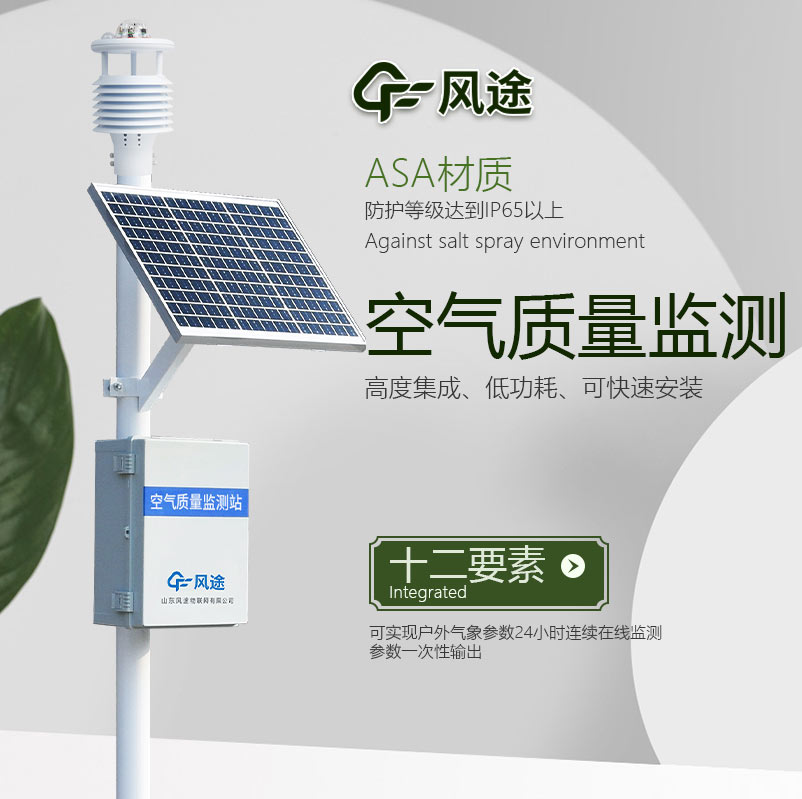Shandong Fengtu IOT Technology Co., Ltd
Sales Manager:Ms. Emily Wang
Cel,Whatsapp,Wechat:+86 15898932201
Email:info@fengtutec.com
Add:No. 155 Optoelectronic Industry Accelerator, Gaoxin District, Weifang, Shandong, China

Sales Manager:Ms. Emily Wang
Cel,Whatsapp,Wechat:+86 15898932201
Email:info@fengtutec.com
Add:No. 155 Optoelectronic Industry Accelerator, Gaoxin District, Weifang, Shandong, China
time:2024-12-17 09:45:38 source:Weather Station viewed:212 time
The Air Quality Monitoring Station plays a crucial role in environmental supervision.
The Air Quality Monitoring Station can monitor the concentrations of various pollutants and meteorological parameters in the air, such as PM2.5, PM10, SO₂, NO₂, CO, O₃, TVOC, etc., in real-time and continuously, providing detailed and accurate data for environmental supervision departments. This enables them to grasp the environmental situation promptly and offers a scientific basis for decision-making. By rationally setting up monitoring points in key areas such as industrial parks, transportation hubs, and construction sites, the pollution sources can be accurately located, helping the supervision departments to take targeted measures and improve supervision efficiency. Moreover, the system transmits data in real-time. Once abnormal situations such as excessive pollutants occur, the supervision departments can respond quickly and handle them in a timely manner to reduce the impact of pollution. It helps to construct a grid-based supervision system, subdividing the monitoring area to achieve comprehensive coverage and refined management, and promotes public participation and improves the transparency of environmental information.
Environmental supervision also drives the development of the Air Quality Monitoring Station. The improvement of supervision requirements prompts the continuous optimization and upgrading of the system to meet the higher requirements for the accuracy, timeliness, and comprehensiveness of air quality monitoring data, enabling it to play a greater role in pollution source analysis, pollution trend prediction, and environmental risk warning. The standards and specifications formulated by the supervision departments ensure the construction, operation, and data quality of the system and expand its application fields, such as for volatile organic compounds, ozone monitoring, and environmental monitoring in rural and remote areas. The supervision needs promote the sharing and integration of monitoring system data with other environmental data to form a unified big data platform, providing in-depth analysis support for comprehensive decision-making.
The Air Quality Monitoring Station and environmental supervision promote each other, jointly contribute to improving air quality and strengthening environmental protection, and drive the continuous progress of environmental governance.

Radar level meter is an advanced instrument widely used in the field of liquid level measurement, especially in all kinds of storage tanks. It adopts a contactless measurement method, which can accurately measure the volume of liquid in storage tanks.The reason why radar level meter is widely used i...
With the rapid development of science and technology, modern meteorological and environmental monitoring systems, as the core of the operational meteorological monitoring system, are of great significance in enhancing the level of public meteorological services and improving the accuracy of meteorol...
"Waterloo" was originally the name of a city, but as time passed, it came to mean something else: a critical event that failed at a decisive point. This is because Napoleon was defeated at Waterloo and went from strength to strength.Victor Hugo wrote in Les Misérables: "If it had not...
From ancient times to the present, agriculture has always been based on agriculture. "Food is the most important thing for the people" shows the importance of agriculture. The damage caused by meteorological disasters that we have been suffering from is also very serious. In order to ensur...